Humanitarian Intervention and Conflict Resolution
VerifiedAdded on 2023/04/21
|12
|3412
|203
AI Summary
This essay discusses the nature of conflict, the importance of peacekeeping and peacebuilding, and the concept of humanitarian intervention. It takes the case study of Timor Leste to analyze the use of humanitarian intervention in conflict resolution. Find study material, solved assignments, and essays on Desklib.
Contribute Materials
Your contribution can guide someone’s learning journey. Share your
documents today.
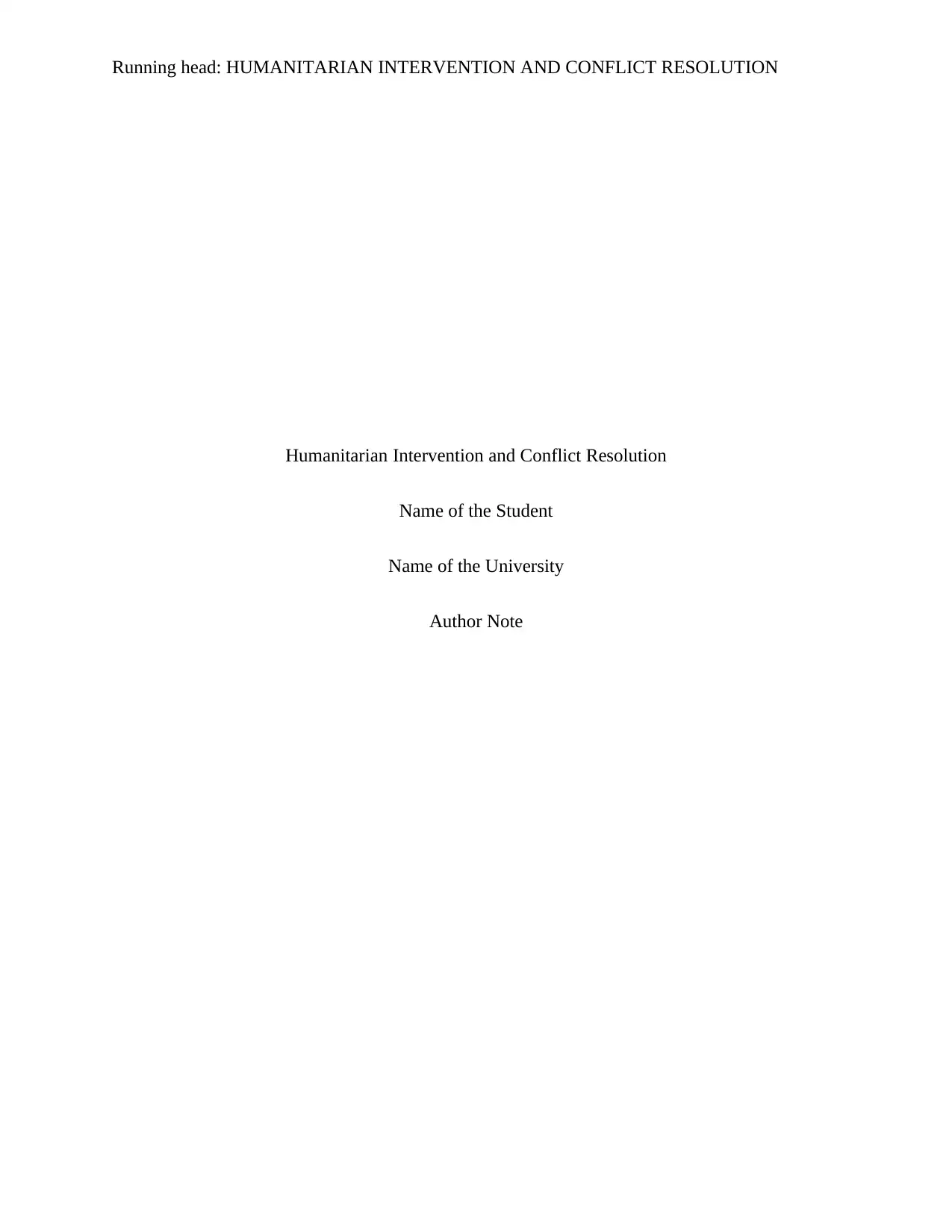
Running head: HUMANITARIAN INTERVENTION AND CONFLICT RESOLUTION
Humanitarian Intervention and Conflict Resolution
Name of the Student
Name of the University
Author Note
Humanitarian Intervention and Conflict Resolution
Name of the Student
Name of the University
Author Note
Secure Best Marks with AI Grader
Need help grading? Try our AI Grader for instant feedback on your assignments.
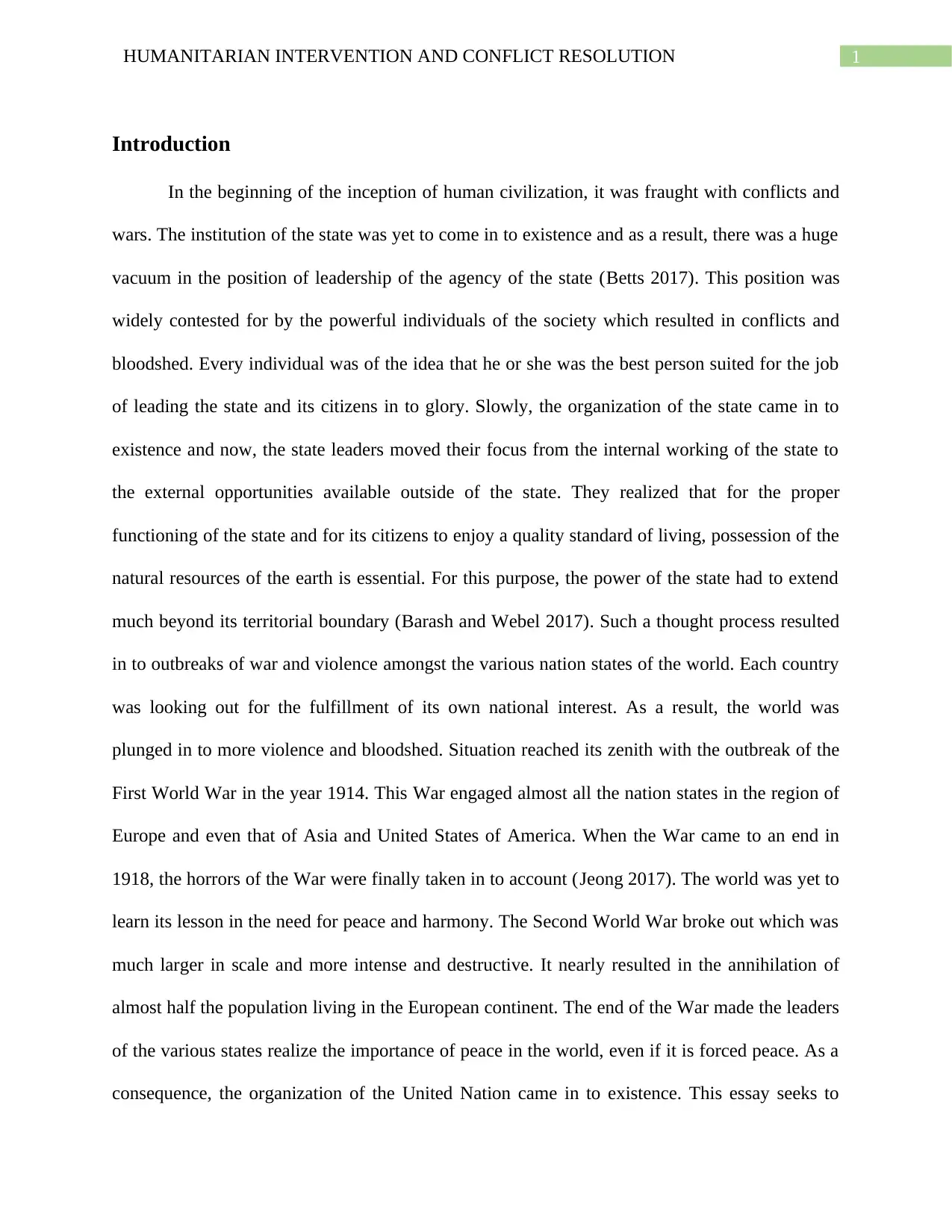
1HUMANITARIAN INTERVENTION AND CONFLICT RESOLUTION
Introduction
In the beginning of the inception of human civilization, it was fraught with conflicts and
wars. The institution of the state was yet to come in to existence and as a result, there was a huge
vacuum in the position of leadership of the agency of the state (Betts 2017). This position was
widely contested for by the powerful individuals of the society which resulted in conflicts and
bloodshed. Every individual was of the idea that he or she was the best person suited for the job
of leading the state and its citizens in to glory. Slowly, the organization of the state came in to
existence and now, the state leaders moved their focus from the internal working of the state to
the external opportunities available outside of the state. They realized that for the proper
functioning of the state and for its citizens to enjoy a quality standard of living, possession of the
natural resources of the earth is essential. For this purpose, the power of the state had to extend
much beyond its territorial boundary (Barash and Webel 2017). Such a thought process resulted
in to outbreaks of war and violence amongst the various nation states of the world. Each country
was looking out for the fulfillment of its own national interest. As a result, the world was
plunged in to more violence and bloodshed. Situation reached its zenith with the outbreak of the
First World War in the year 1914. This War engaged almost all the nation states in the region of
Europe and even that of Asia and United States of America. When the War came to an end in
1918, the horrors of the War were finally taken in to account (Jeong 2017). The world was yet to
learn its lesson in the need for peace and harmony. The Second World War broke out which was
much larger in scale and more intense and destructive. It nearly resulted in the annihilation of
almost half the population living in the European continent. The end of the War made the leaders
of the various states realize the importance of peace in the world, even if it is forced peace. As a
consequence, the organization of the United Nation came in to existence. This essay seeks to
Introduction
In the beginning of the inception of human civilization, it was fraught with conflicts and
wars. The institution of the state was yet to come in to existence and as a result, there was a huge
vacuum in the position of leadership of the agency of the state (Betts 2017). This position was
widely contested for by the powerful individuals of the society which resulted in conflicts and
bloodshed. Every individual was of the idea that he or she was the best person suited for the job
of leading the state and its citizens in to glory. Slowly, the organization of the state came in to
existence and now, the state leaders moved their focus from the internal working of the state to
the external opportunities available outside of the state. They realized that for the proper
functioning of the state and for its citizens to enjoy a quality standard of living, possession of the
natural resources of the earth is essential. For this purpose, the power of the state had to extend
much beyond its territorial boundary (Barash and Webel 2017). Such a thought process resulted
in to outbreaks of war and violence amongst the various nation states of the world. Each country
was looking out for the fulfillment of its own national interest. As a result, the world was
plunged in to more violence and bloodshed. Situation reached its zenith with the outbreak of the
First World War in the year 1914. This War engaged almost all the nation states in the region of
Europe and even that of Asia and United States of America. When the War came to an end in
1918, the horrors of the War were finally taken in to account (Jeong 2017). The world was yet to
learn its lesson in the need for peace and harmony. The Second World War broke out which was
much larger in scale and more intense and destructive. It nearly resulted in the annihilation of
almost half the population living in the European continent. The end of the War made the leaders
of the various states realize the importance of peace in the world, even if it is forced peace. As a
consequence, the organization of the United Nation came in to existence. This essay seeks to
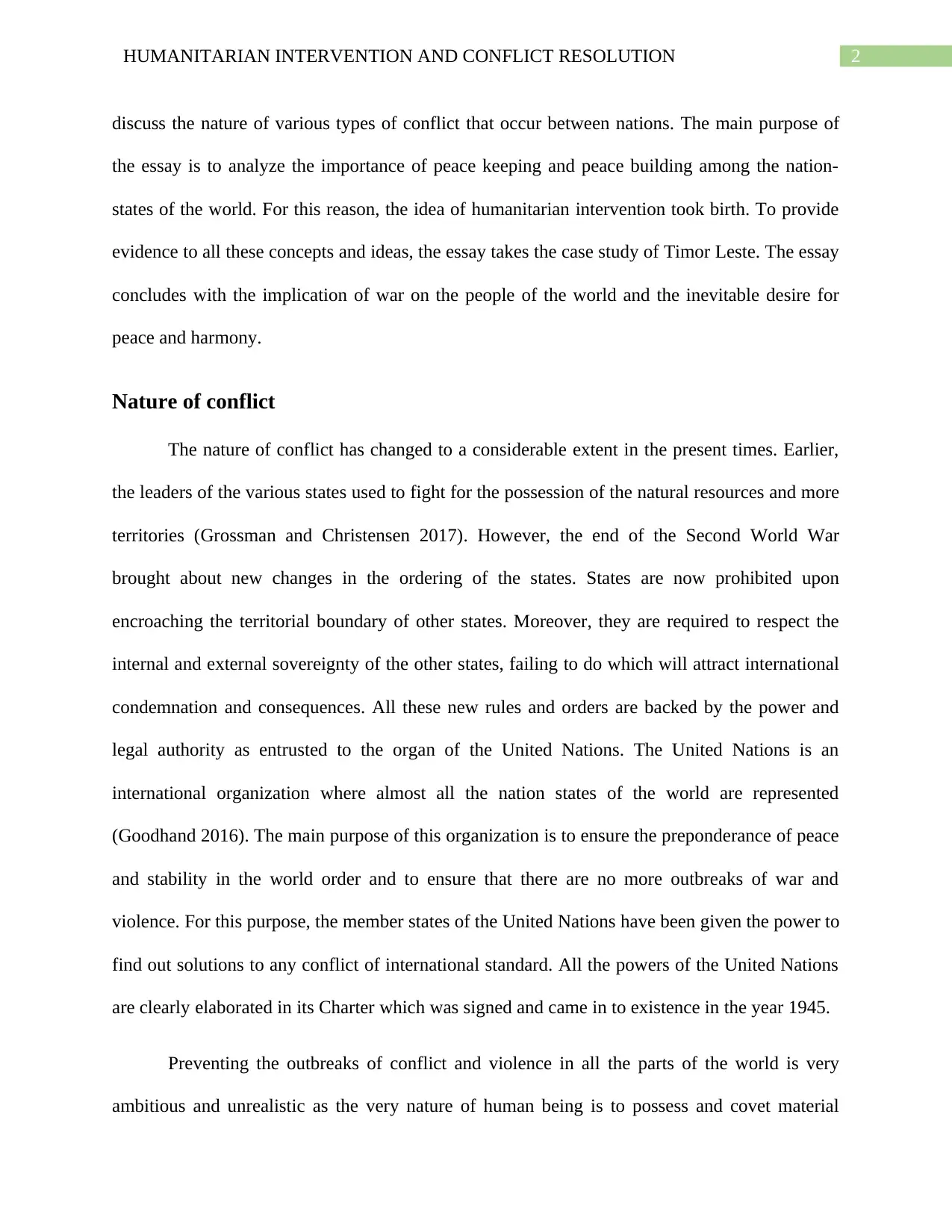
2HUMANITARIAN INTERVENTION AND CONFLICT RESOLUTION
discuss the nature of various types of conflict that occur between nations. The main purpose of
the essay is to analyze the importance of peace keeping and peace building among the nation-
states of the world. For this reason, the idea of humanitarian intervention took birth. To provide
evidence to all these concepts and ideas, the essay takes the case study of Timor Leste. The essay
concludes with the implication of war on the people of the world and the inevitable desire for
peace and harmony.
Nature of conflict
The nature of conflict has changed to a considerable extent in the present times. Earlier,
the leaders of the various states used to fight for the possession of the natural resources and more
territories (Grossman and Christensen 2017). However, the end of the Second World War
brought about new changes in the ordering of the states. States are now prohibited upon
encroaching the territorial boundary of other states. Moreover, they are required to respect the
internal and external sovereignty of the other states, failing to do which will attract international
condemnation and consequences. All these new rules and orders are backed by the power and
legal authority as entrusted to the organ of the United Nations. The United Nations is an
international organization where almost all the nation states of the world are represented
(Goodhand 2016). The main purpose of this organization is to ensure the preponderance of peace
and stability in the world order and to ensure that there are no more outbreaks of war and
violence. For this purpose, the member states of the United Nations have been given the power to
find out solutions to any conflict of international standard. All the powers of the United Nations
are clearly elaborated in its Charter which was signed and came in to existence in the year 1945.
Preventing the outbreaks of conflict and violence in all the parts of the world is very
ambitious and unrealistic as the very nature of human being is to possess and covet material
discuss the nature of various types of conflict that occur between nations. The main purpose of
the essay is to analyze the importance of peace keeping and peace building among the nation-
states of the world. For this reason, the idea of humanitarian intervention took birth. To provide
evidence to all these concepts and ideas, the essay takes the case study of Timor Leste. The essay
concludes with the implication of war on the people of the world and the inevitable desire for
peace and harmony.
Nature of conflict
The nature of conflict has changed to a considerable extent in the present times. Earlier,
the leaders of the various states used to fight for the possession of the natural resources and more
territories (Grossman and Christensen 2017). However, the end of the Second World War
brought about new changes in the ordering of the states. States are now prohibited upon
encroaching the territorial boundary of other states. Moreover, they are required to respect the
internal and external sovereignty of the other states, failing to do which will attract international
condemnation and consequences. All these new rules and orders are backed by the power and
legal authority as entrusted to the organ of the United Nations. The United Nations is an
international organization where almost all the nation states of the world are represented
(Goodhand 2016). The main purpose of this organization is to ensure the preponderance of peace
and stability in the world order and to ensure that there are no more outbreaks of war and
violence. For this purpose, the member states of the United Nations have been given the power to
find out solutions to any conflict of international standard. All the powers of the United Nations
are clearly elaborated in its Charter which was signed and came in to existence in the year 1945.
Preventing the outbreaks of conflict and violence in all the parts of the world is very
ambitious and unrealistic as the very nature of human being is to possess and covet material
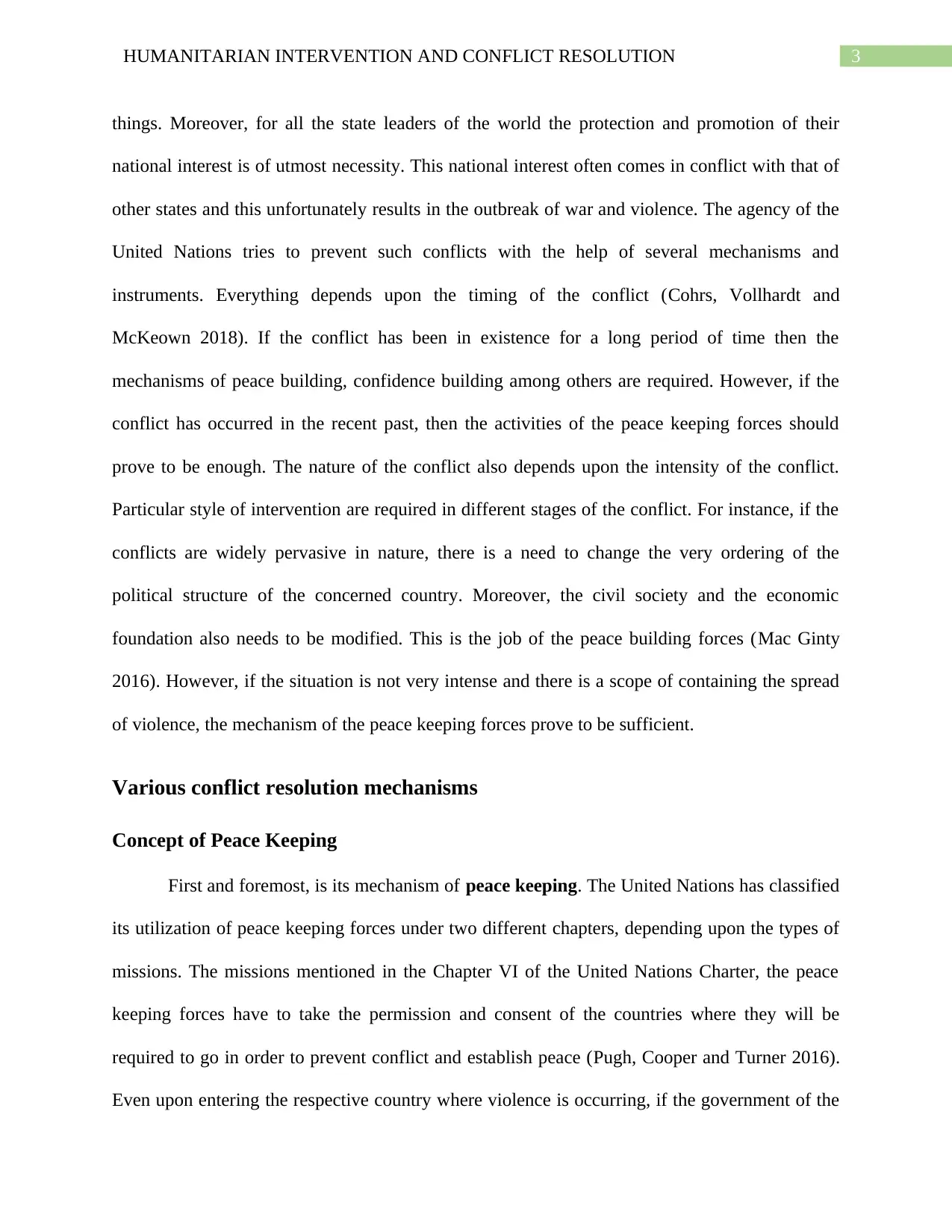
3HUMANITARIAN INTERVENTION AND CONFLICT RESOLUTION
things. Moreover, for all the state leaders of the world the protection and promotion of their
national interest is of utmost necessity. This national interest often comes in conflict with that of
other states and this unfortunately results in the outbreak of war and violence. The agency of the
United Nations tries to prevent such conflicts with the help of several mechanisms and
instruments. Everything depends upon the timing of the conflict (Cohrs, Vollhardt and
McKeown 2018). If the conflict has been in existence for a long period of time then the
mechanisms of peace building, confidence building among others are required. However, if the
conflict has occurred in the recent past, then the activities of the peace keeping forces should
prove to be enough. The nature of the conflict also depends upon the intensity of the conflict.
Particular style of intervention are required in different stages of the conflict. For instance, if the
conflicts are widely pervasive in nature, there is a need to change the very ordering of the
political structure of the concerned country. Moreover, the civil society and the economic
foundation also needs to be modified. This is the job of the peace building forces (Mac Ginty
2016). However, if the situation is not very intense and there is a scope of containing the spread
of violence, the mechanism of the peace keeping forces prove to be sufficient.
Various conflict resolution mechanisms
Concept of Peace Keeping
First and foremost, is its mechanism of peace keeping. The United Nations has classified
its utilization of peace keeping forces under two different chapters, depending upon the types of
missions. The missions mentioned in the Chapter VI of the United Nations Charter, the peace
keeping forces have to take the permission and consent of the countries where they will be
required to go in order to prevent conflict and establish peace (Pugh, Cooper and Turner 2016).
Even upon entering the respective country where violence is occurring, if the government of the
things. Moreover, for all the state leaders of the world the protection and promotion of their
national interest is of utmost necessity. This national interest often comes in conflict with that of
other states and this unfortunately results in the outbreak of war and violence. The agency of the
United Nations tries to prevent such conflicts with the help of several mechanisms and
instruments. Everything depends upon the timing of the conflict (Cohrs, Vollhardt and
McKeown 2018). If the conflict has been in existence for a long period of time then the
mechanisms of peace building, confidence building among others are required. However, if the
conflict has occurred in the recent past, then the activities of the peace keeping forces should
prove to be enough. The nature of the conflict also depends upon the intensity of the conflict.
Particular style of intervention are required in different stages of the conflict. For instance, if the
conflicts are widely pervasive in nature, there is a need to change the very ordering of the
political structure of the concerned country. Moreover, the civil society and the economic
foundation also needs to be modified. This is the job of the peace building forces (Mac Ginty
2016). However, if the situation is not very intense and there is a scope of containing the spread
of violence, the mechanism of the peace keeping forces prove to be sufficient.
Various conflict resolution mechanisms
Concept of Peace Keeping
First and foremost, is its mechanism of peace keeping. The United Nations has classified
its utilization of peace keeping forces under two different chapters, depending upon the types of
missions. The missions mentioned in the Chapter VI of the United Nations Charter, the peace
keeping forces have to take the permission and consent of the countries where they will be
required to go in order to prevent conflict and establish peace (Pugh, Cooper and Turner 2016).
Even upon entering the respective country where violence is occurring, if the government of the
Secure Best Marks with AI Grader
Need help grading? Try our AI Grader for instant feedback on your assignments.
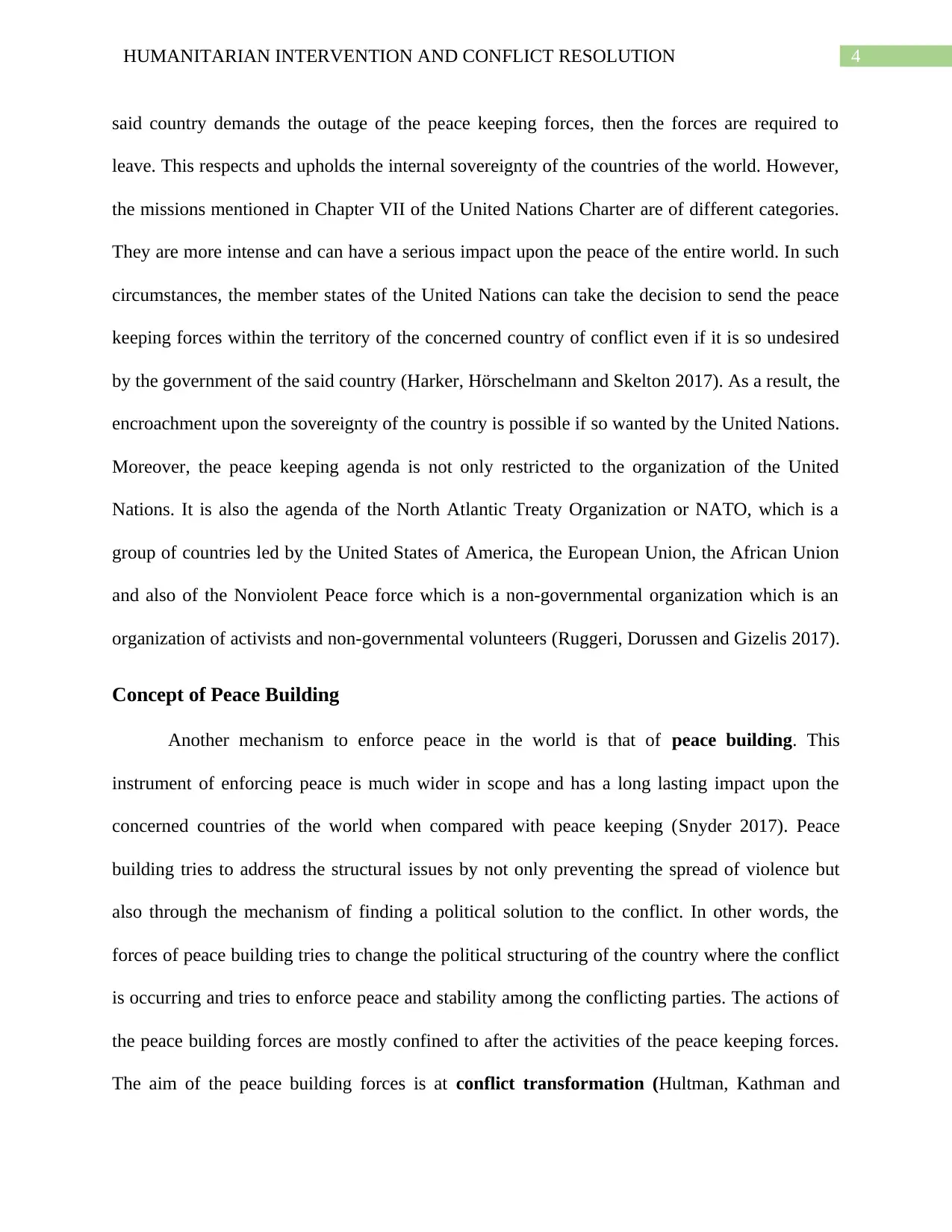
4HUMANITARIAN INTERVENTION AND CONFLICT RESOLUTION
said country demands the outage of the peace keeping forces, then the forces are required to
leave. This respects and upholds the internal sovereignty of the countries of the world. However,
the missions mentioned in Chapter VII of the United Nations Charter are of different categories.
They are more intense and can have a serious impact upon the peace of the entire world. In such
circumstances, the member states of the United Nations can take the decision to send the peace
keeping forces within the territory of the concerned country of conflict even if it is so undesired
by the government of the said country (Harker, Hörschelmann and Skelton 2017). As a result, the
encroachment upon the sovereignty of the country is possible if so wanted by the United Nations.
Moreover, the peace keeping agenda is not only restricted to the organization of the United
Nations. It is also the agenda of the North Atlantic Treaty Organization or NATO, which is a
group of countries led by the United States of America, the European Union, the African Union
and also of the Nonviolent Peace force which is a non-governmental organization which is an
organization of activists and non-governmental volunteers (Ruggeri, Dorussen and Gizelis 2017).
Concept of Peace Building
Another mechanism to enforce peace in the world is that of peace building. This
instrument of enforcing peace is much wider in scope and has a long lasting impact upon the
concerned countries of the world when compared with peace keeping (Snyder 2017). Peace
building tries to address the structural issues by not only preventing the spread of violence but
also through the mechanism of finding a political solution to the conflict. In other words, the
forces of peace building tries to change the political structuring of the country where the conflict
is occurring and tries to enforce peace and stability among the conflicting parties. The actions of
the peace building forces are mostly confined to after the activities of the peace keeping forces.
The aim of the peace building forces is at conflict transformation (Hultman, Kathman and
said country demands the outage of the peace keeping forces, then the forces are required to
leave. This respects and upholds the internal sovereignty of the countries of the world. However,
the missions mentioned in Chapter VII of the United Nations Charter are of different categories.
They are more intense and can have a serious impact upon the peace of the entire world. In such
circumstances, the member states of the United Nations can take the decision to send the peace
keeping forces within the territory of the concerned country of conflict even if it is so undesired
by the government of the said country (Harker, Hörschelmann and Skelton 2017). As a result, the
encroachment upon the sovereignty of the country is possible if so wanted by the United Nations.
Moreover, the peace keeping agenda is not only restricted to the organization of the United
Nations. It is also the agenda of the North Atlantic Treaty Organization or NATO, which is a
group of countries led by the United States of America, the European Union, the African Union
and also of the Nonviolent Peace force which is a non-governmental organization which is an
organization of activists and non-governmental volunteers (Ruggeri, Dorussen and Gizelis 2017).
Concept of Peace Building
Another mechanism to enforce peace in the world is that of peace building. This
instrument of enforcing peace is much wider in scope and has a long lasting impact upon the
concerned countries of the world when compared with peace keeping (Snyder 2017). Peace
building tries to address the structural issues by not only preventing the spread of violence but
also through the mechanism of finding a political solution to the conflict. In other words, the
forces of peace building tries to change the political structuring of the country where the conflict
is occurring and tries to enforce peace and stability among the conflicting parties. The actions of
the peace building forces are mostly confined to after the activities of the peace keeping forces.
The aim of the peace building forces is at conflict transformation (Hultman, Kathman and
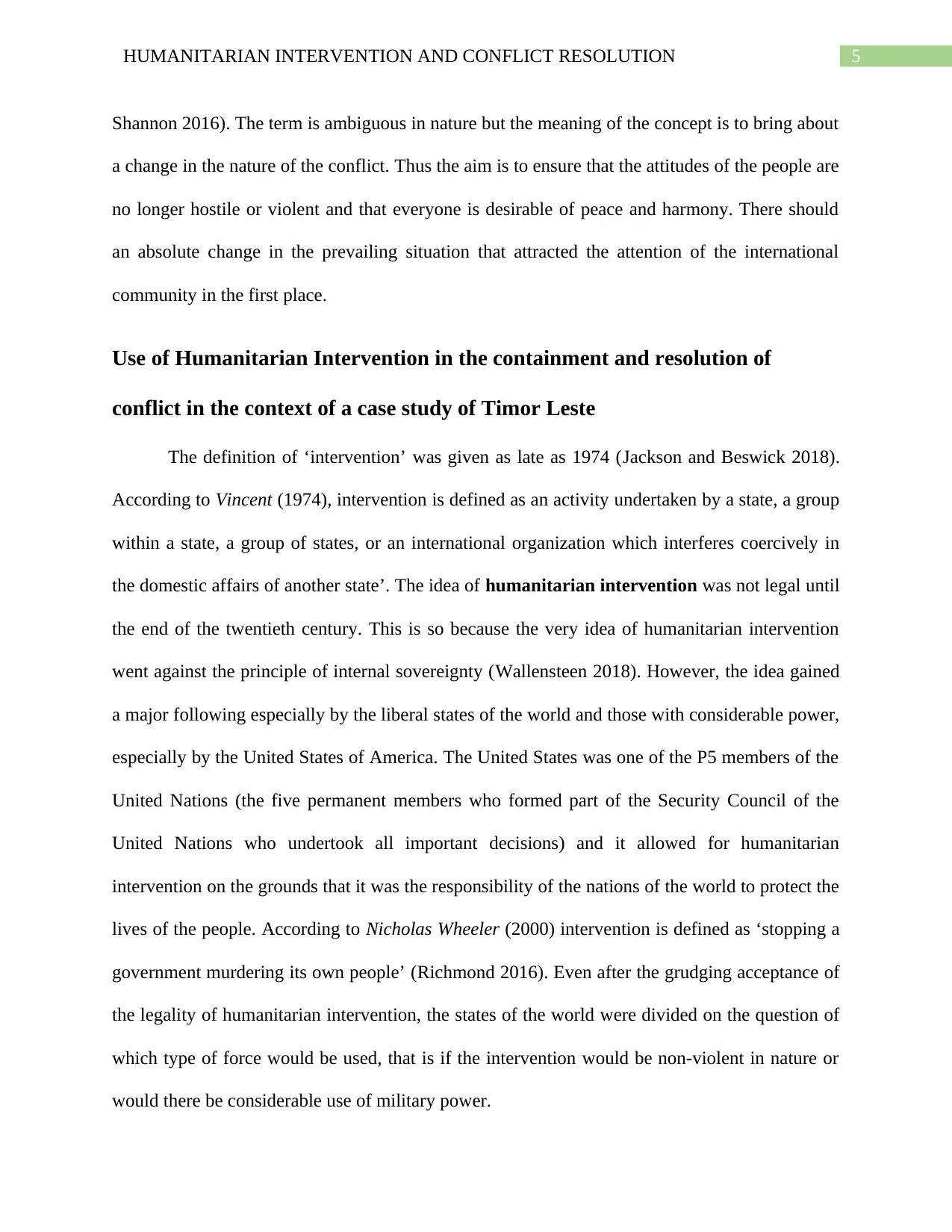
5HUMANITARIAN INTERVENTION AND CONFLICT RESOLUTION
Shannon 2016). The term is ambiguous in nature but the meaning of the concept is to bring about
a change in the nature of the conflict. Thus the aim is to ensure that the attitudes of the people are
no longer hostile or violent and that everyone is desirable of peace and harmony. There should
an absolute change in the prevailing situation that attracted the attention of the international
community in the first place.
Use of Humanitarian Intervention in the containment and resolution of
conflict in the context of a case study of Timor Leste
The definition of ‘intervention’ was given as late as 1974 (Jackson and Beswick 2018).
According to Vincent (1974), intervention is defined as an activity undertaken by a state, a group
within a state, a group of states, or an international organization which interferes coercively in
the domestic affairs of another state’. The idea of humanitarian intervention was not legal until
the end of the twentieth century. This is so because the very idea of humanitarian intervention
went against the principle of internal sovereignty (Wallensteen 2018). However, the idea gained
a major following especially by the liberal states of the world and those with considerable power,
especially by the United States of America. The United States was one of the P5 members of the
United Nations (the five permanent members who formed part of the Security Council of the
United Nations who undertook all important decisions) and it allowed for humanitarian
intervention on the grounds that it was the responsibility of the nations of the world to protect the
lives of the people. According to Nicholas Wheeler (2000) intervention is defined as ‘stopping a
government murdering its own people’ (Richmond 2016). Even after the grudging acceptance of
the legality of humanitarian intervention, the states of the world were divided on the question of
which type of force would be used, that is if the intervention would be non-violent in nature or
would there be considerable use of military power.
Shannon 2016). The term is ambiguous in nature but the meaning of the concept is to bring about
a change in the nature of the conflict. Thus the aim is to ensure that the attitudes of the people are
no longer hostile or violent and that everyone is desirable of peace and harmony. There should
an absolute change in the prevailing situation that attracted the attention of the international
community in the first place.
Use of Humanitarian Intervention in the containment and resolution of
conflict in the context of a case study of Timor Leste
The definition of ‘intervention’ was given as late as 1974 (Jackson and Beswick 2018).
According to Vincent (1974), intervention is defined as an activity undertaken by a state, a group
within a state, a group of states, or an international organization which interferes coercively in
the domestic affairs of another state’. The idea of humanitarian intervention was not legal until
the end of the twentieth century. This is so because the very idea of humanitarian intervention
went against the principle of internal sovereignty (Wallensteen 2018). However, the idea gained
a major following especially by the liberal states of the world and those with considerable power,
especially by the United States of America. The United States was one of the P5 members of the
United Nations (the five permanent members who formed part of the Security Council of the
United Nations who undertook all important decisions) and it allowed for humanitarian
intervention on the grounds that it was the responsibility of the nations of the world to protect the
lives of the people. According to Nicholas Wheeler (2000) intervention is defined as ‘stopping a
government murdering its own people’ (Richmond 2016). Even after the grudging acceptance of
the legality of humanitarian intervention, the states of the world were divided on the question of
which type of force would be used, that is if the intervention would be non-violent in nature or
would there be considerable use of military power.
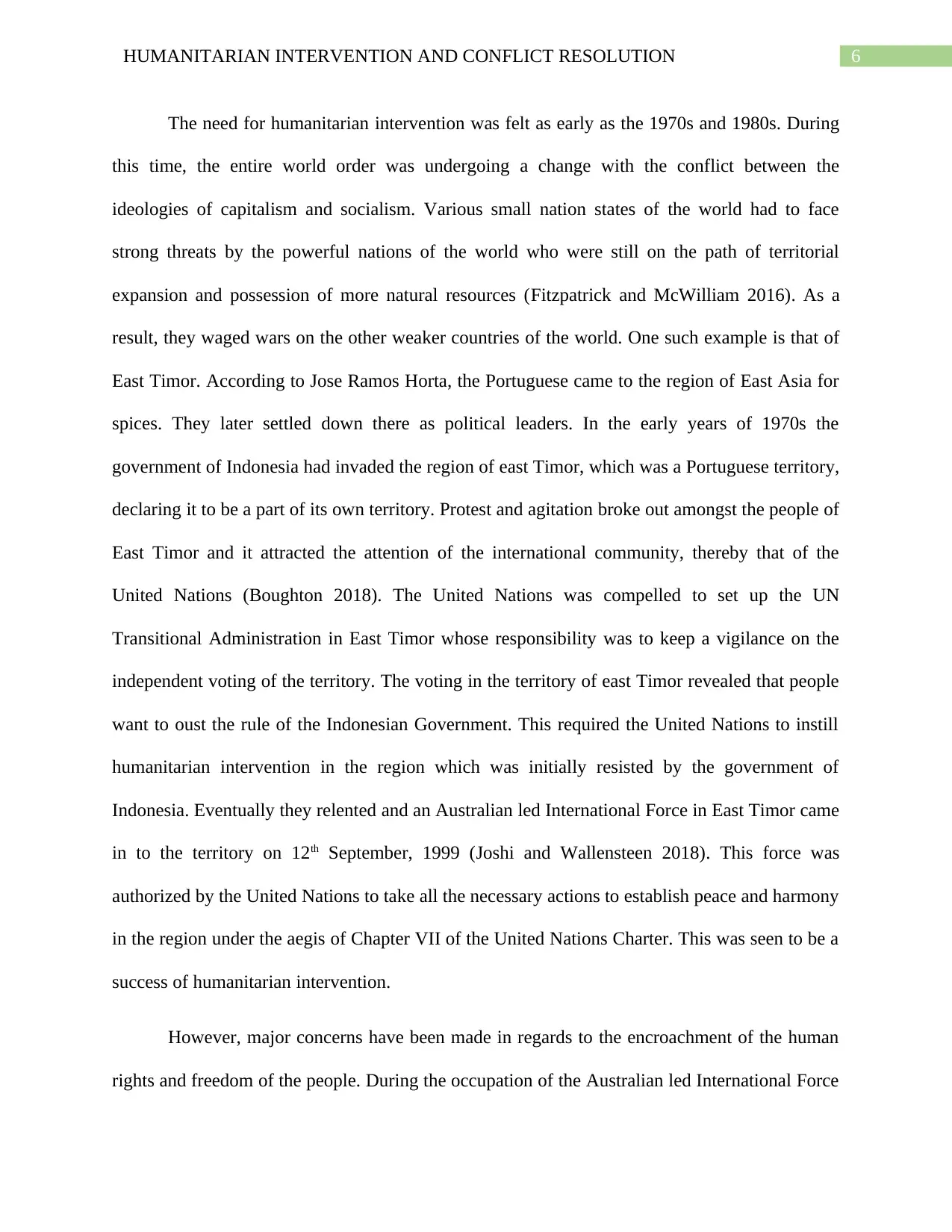
6HUMANITARIAN INTERVENTION AND CONFLICT RESOLUTION
The need for humanitarian intervention was felt as early as the 1970s and 1980s. During
this time, the entire world order was undergoing a change with the conflict between the
ideologies of capitalism and socialism. Various small nation states of the world had to face
strong threats by the powerful nations of the world who were still on the path of territorial
expansion and possession of more natural resources (Fitzpatrick and McWilliam 2016). As a
result, they waged wars on the other weaker countries of the world. One such example is that of
East Timor. According to Jose Ramos Horta, the Portuguese came to the region of East Asia for
spices. They later settled down there as political leaders. In the early years of 1970s the
government of Indonesia had invaded the region of east Timor, which was a Portuguese territory,
declaring it to be a part of its own territory. Protest and agitation broke out amongst the people of
East Timor and it attracted the attention of the international community, thereby that of the
United Nations (Boughton 2018). The United Nations was compelled to set up the UN
Transitional Administration in East Timor whose responsibility was to keep a vigilance on the
independent voting of the territory. The voting in the territory of east Timor revealed that people
want to oust the rule of the Indonesian Government. This required the United Nations to instill
humanitarian intervention in the region which was initially resisted by the government of
Indonesia. Eventually they relented and an Australian led International Force in East Timor came
in to the territory on 12th September, 1999 (Joshi and Wallensteen 2018). This force was
authorized by the United Nations to take all the necessary actions to establish peace and harmony
in the region under the aegis of Chapter VII of the United Nations Charter. This was seen to be a
success of humanitarian intervention.
However, major concerns have been made in regards to the encroachment of the human
rights and freedom of the people. During the occupation of the Australian led International Force
The need for humanitarian intervention was felt as early as the 1970s and 1980s. During
this time, the entire world order was undergoing a change with the conflict between the
ideologies of capitalism and socialism. Various small nation states of the world had to face
strong threats by the powerful nations of the world who were still on the path of territorial
expansion and possession of more natural resources (Fitzpatrick and McWilliam 2016). As a
result, they waged wars on the other weaker countries of the world. One such example is that of
East Timor. According to Jose Ramos Horta, the Portuguese came to the region of East Asia for
spices. They later settled down there as political leaders. In the early years of 1970s the
government of Indonesia had invaded the region of east Timor, which was a Portuguese territory,
declaring it to be a part of its own territory. Protest and agitation broke out amongst the people of
East Timor and it attracted the attention of the international community, thereby that of the
United Nations (Boughton 2018). The United Nations was compelled to set up the UN
Transitional Administration in East Timor whose responsibility was to keep a vigilance on the
independent voting of the territory. The voting in the territory of east Timor revealed that people
want to oust the rule of the Indonesian Government. This required the United Nations to instill
humanitarian intervention in the region which was initially resisted by the government of
Indonesia. Eventually they relented and an Australian led International Force in East Timor came
in to the territory on 12th September, 1999 (Joshi and Wallensteen 2018). This force was
authorized by the United Nations to take all the necessary actions to establish peace and harmony
in the region under the aegis of Chapter VII of the United Nations Charter. This was seen to be a
success of humanitarian intervention.
However, major concerns have been made in regards to the encroachment of the human
rights and freedom of the people. During the occupation of the Australian led International Force
Paraphrase This Document
Need a fresh take? Get an instant paraphrase of this document with our AI Paraphraser
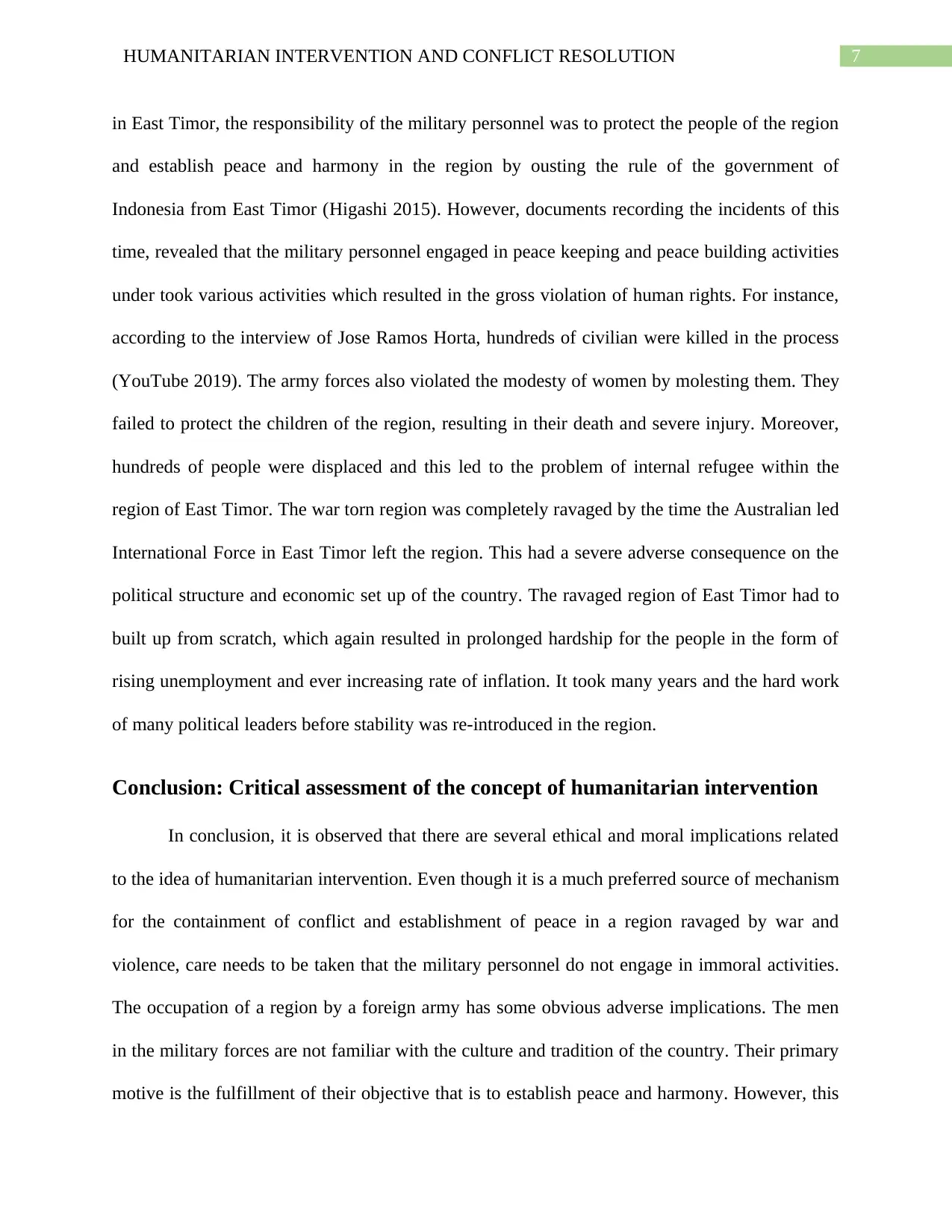
7HUMANITARIAN INTERVENTION AND CONFLICT RESOLUTION
in East Timor, the responsibility of the military personnel was to protect the people of the region
and establish peace and harmony in the region by ousting the rule of the government of
Indonesia from East Timor (Higashi 2015). However, documents recording the incidents of this
time, revealed that the military personnel engaged in peace keeping and peace building activities
under took various activities which resulted in the gross violation of human rights. For instance,
according to the interview of Jose Ramos Horta, hundreds of civilian were killed in the process
(YouTube 2019). The army forces also violated the modesty of women by molesting them. They
failed to protect the children of the region, resulting in their death and severe injury. Moreover,
hundreds of people were displaced and this led to the problem of internal refugee within the
region of East Timor. The war torn region was completely ravaged by the time the Australian led
International Force in East Timor left the region. This had a severe adverse consequence on the
political structure and economic set up of the country. The ravaged region of East Timor had to
built up from scratch, which again resulted in prolonged hardship for the people in the form of
rising unemployment and ever increasing rate of inflation. It took many years and the hard work
of many political leaders before stability was re-introduced in the region.
Conclusion: Critical assessment of the concept of humanitarian intervention
In conclusion, it is observed that there are several ethical and moral implications related
to the idea of humanitarian intervention. Even though it is a much preferred source of mechanism
for the containment of conflict and establishment of peace in a region ravaged by war and
violence, care needs to be taken that the military personnel do not engage in immoral activities.
The occupation of a region by a foreign army has some obvious adverse implications. The men
in the military forces are not familiar with the culture and tradition of the country. Their primary
motive is the fulfillment of their objective that is to establish peace and harmony. However, this
in East Timor, the responsibility of the military personnel was to protect the people of the region
and establish peace and harmony in the region by ousting the rule of the government of
Indonesia from East Timor (Higashi 2015). However, documents recording the incidents of this
time, revealed that the military personnel engaged in peace keeping and peace building activities
under took various activities which resulted in the gross violation of human rights. For instance,
according to the interview of Jose Ramos Horta, hundreds of civilian were killed in the process
(YouTube 2019). The army forces also violated the modesty of women by molesting them. They
failed to protect the children of the region, resulting in their death and severe injury. Moreover,
hundreds of people were displaced and this led to the problem of internal refugee within the
region of East Timor. The war torn region was completely ravaged by the time the Australian led
International Force in East Timor left the region. This had a severe adverse consequence on the
political structure and economic set up of the country. The ravaged region of East Timor had to
built up from scratch, which again resulted in prolonged hardship for the people in the form of
rising unemployment and ever increasing rate of inflation. It took many years and the hard work
of many political leaders before stability was re-introduced in the region.
Conclusion: Critical assessment of the concept of humanitarian intervention
In conclusion, it is observed that there are several ethical and moral implications related
to the idea of humanitarian intervention. Even though it is a much preferred source of mechanism
for the containment of conflict and establishment of peace in a region ravaged by war and
violence, care needs to be taken that the military personnel do not engage in immoral activities.
The occupation of a region by a foreign army has some obvious adverse implications. The men
in the military forces are not familiar with the culture and tradition of the country. Their primary
motive is the fulfillment of their objective that is to establish peace and harmony. However, this
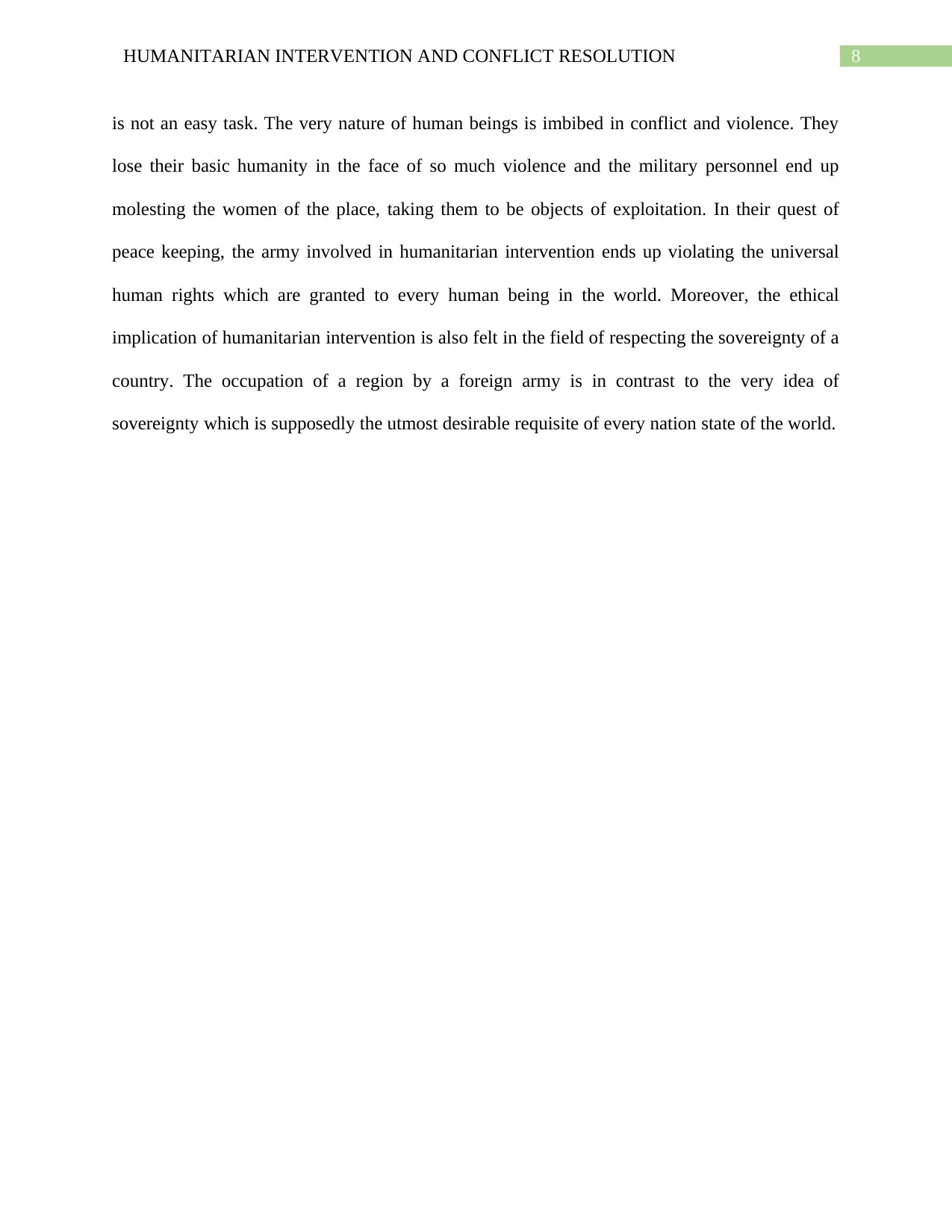
8HUMANITARIAN INTERVENTION AND CONFLICT RESOLUTION
is not an easy task. The very nature of human beings is imbibed in conflict and violence. They
lose their basic humanity in the face of so much violence and the military personnel end up
molesting the women of the place, taking them to be objects of exploitation. In their quest of
peace keeping, the army involved in humanitarian intervention ends up violating the universal
human rights which are granted to every human being in the world. Moreover, the ethical
implication of humanitarian intervention is also felt in the field of respecting the sovereignty of a
country. The occupation of a region by a foreign army is in contrast to the very idea of
sovereignty which is supposedly the utmost desirable requisite of every nation state of the world.
is not an easy task. The very nature of human beings is imbibed in conflict and violence. They
lose their basic humanity in the face of so much violence and the military personnel end up
molesting the women of the place, taking them to be objects of exploitation. In their quest of
peace keeping, the army involved in humanitarian intervention ends up violating the universal
human rights which are granted to every human being in the world. Moreover, the ethical
implication of humanitarian intervention is also felt in the field of respecting the sovereignty of a
country. The occupation of a region by a foreign army is in contrast to the very idea of
sovereignty which is supposedly the utmost desirable requisite of every nation state of the world.
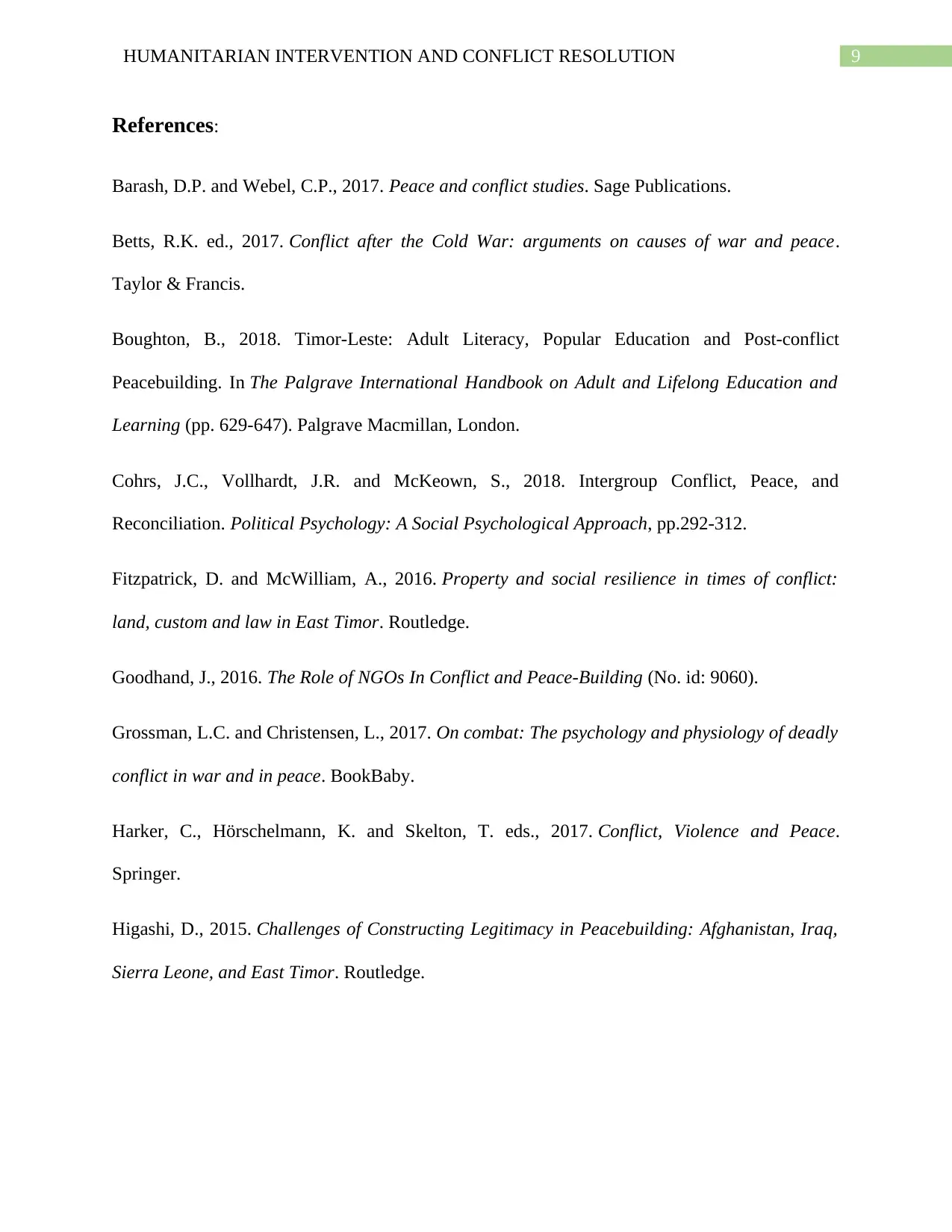
9HUMANITARIAN INTERVENTION AND CONFLICT RESOLUTION
References:
Barash, D.P. and Webel, C.P., 2017. Peace and conflict studies. Sage Publications.
Betts, R.K. ed., 2017. Conflict after the Cold War: arguments on causes of war and peace.
Taylor & Francis.
Boughton, B., 2018. Timor-Leste: Adult Literacy, Popular Education and Post-conflict
Peacebuilding. In The Palgrave International Handbook on Adult and Lifelong Education and
Learning (pp. 629-647). Palgrave Macmillan, London.
Cohrs, J.C., Vollhardt, J.R. and McKeown, S., 2018. Intergroup Conflict, Peace, and
Reconciliation. Political Psychology: A Social Psychological Approach, pp.292-312.
Fitzpatrick, D. and McWilliam, A., 2016. Property and social resilience in times of conflict:
land, custom and law in East Timor. Routledge.
Goodhand, J., 2016. The Role of NGOs In Conflict and Peace-Building (No. id: 9060).
Grossman, L.C. and Christensen, L., 2017. On combat: The psychology and physiology of deadly
conflict in war and in peace. BookBaby.
Harker, C., Hörschelmann, K. and Skelton, T. eds., 2017. Conflict, Violence and Peace.
Springer.
Higashi, D., 2015. Challenges of Constructing Legitimacy in Peacebuilding: Afghanistan, Iraq,
Sierra Leone, and East Timor. Routledge.
References:
Barash, D.P. and Webel, C.P., 2017. Peace and conflict studies. Sage Publications.
Betts, R.K. ed., 2017. Conflict after the Cold War: arguments on causes of war and peace.
Taylor & Francis.
Boughton, B., 2018. Timor-Leste: Adult Literacy, Popular Education and Post-conflict
Peacebuilding. In The Palgrave International Handbook on Adult and Lifelong Education and
Learning (pp. 629-647). Palgrave Macmillan, London.
Cohrs, J.C., Vollhardt, J.R. and McKeown, S., 2018. Intergroup Conflict, Peace, and
Reconciliation. Political Psychology: A Social Psychological Approach, pp.292-312.
Fitzpatrick, D. and McWilliam, A., 2016. Property and social resilience in times of conflict:
land, custom and law in East Timor. Routledge.
Goodhand, J., 2016. The Role of NGOs In Conflict and Peace-Building (No. id: 9060).
Grossman, L.C. and Christensen, L., 2017. On combat: The psychology and physiology of deadly
conflict in war and in peace. BookBaby.
Harker, C., Hörschelmann, K. and Skelton, T. eds., 2017. Conflict, Violence and Peace.
Springer.
Higashi, D., 2015. Challenges of Constructing Legitimacy in Peacebuilding: Afghanistan, Iraq,
Sierra Leone, and East Timor. Routledge.
Secure Best Marks with AI Grader
Need help grading? Try our AI Grader for instant feedback on your assignments.
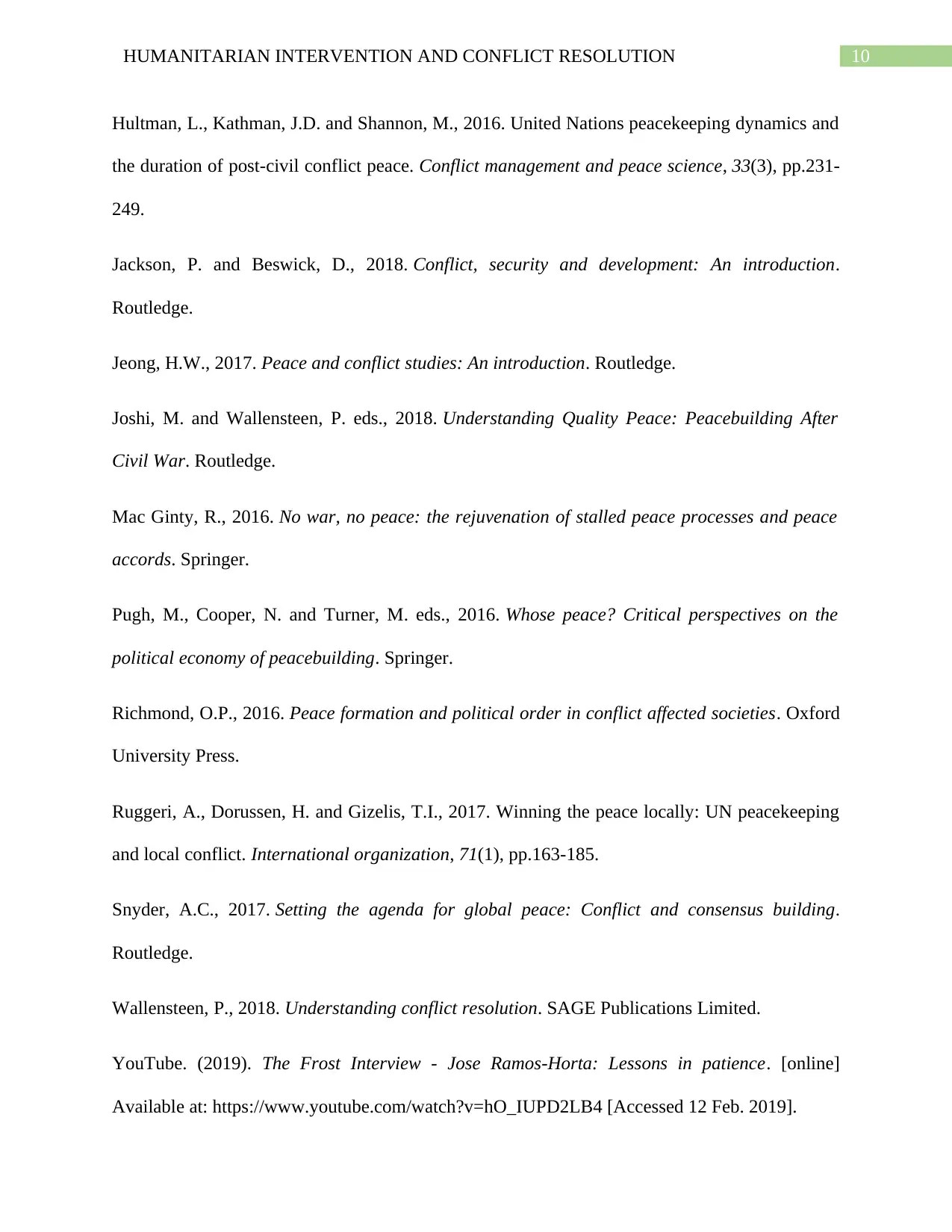
10HUMANITARIAN INTERVENTION AND CONFLICT RESOLUTION
Hultman, L., Kathman, J.D. and Shannon, M., 2016. United Nations peacekeeping dynamics and
the duration of post-civil conflict peace. Conflict management and peace science, 33(3), pp.231-
249.
Jackson, P. and Beswick, D., 2018. Conflict, security and development: An introduction.
Routledge.
Jeong, H.W., 2017. Peace and conflict studies: An introduction. Routledge.
Joshi, M. and Wallensteen, P. eds., 2018. Understanding Quality Peace: Peacebuilding After
Civil War. Routledge.
Mac Ginty, R., 2016. No war, no peace: the rejuvenation of stalled peace processes and peace
accords. Springer.
Pugh, M., Cooper, N. and Turner, M. eds., 2016. Whose peace? Critical perspectives on the
political economy of peacebuilding. Springer.
Richmond, O.P., 2016. Peace formation and political order in conflict affected societies. Oxford
University Press.
Ruggeri, A., Dorussen, H. and Gizelis, T.I., 2017. Winning the peace locally: UN peacekeeping
and local conflict. International organization, 71(1), pp.163-185.
Snyder, A.C., 2017. Setting the agenda for global peace: Conflict and consensus building.
Routledge.
Wallensteen, P., 2018. Understanding conflict resolution. SAGE Publications Limited.
YouTube. (2019). The Frost Interview - Jose Ramos-Horta: Lessons in patience. [online]
Available at: https://www.youtube.com/watch?v=hO_IUPD2LB4 [Accessed 12 Feb. 2019].
Hultman, L., Kathman, J.D. and Shannon, M., 2016. United Nations peacekeeping dynamics and
the duration of post-civil conflict peace. Conflict management and peace science, 33(3), pp.231-
249.
Jackson, P. and Beswick, D., 2018. Conflict, security and development: An introduction.
Routledge.
Jeong, H.W., 2017. Peace and conflict studies: An introduction. Routledge.
Joshi, M. and Wallensteen, P. eds., 2018. Understanding Quality Peace: Peacebuilding After
Civil War. Routledge.
Mac Ginty, R., 2016. No war, no peace: the rejuvenation of stalled peace processes and peace
accords. Springer.
Pugh, M., Cooper, N. and Turner, M. eds., 2016. Whose peace? Critical perspectives on the
political economy of peacebuilding. Springer.
Richmond, O.P., 2016. Peace formation and political order in conflict affected societies. Oxford
University Press.
Ruggeri, A., Dorussen, H. and Gizelis, T.I., 2017. Winning the peace locally: UN peacekeeping
and local conflict. International organization, 71(1), pp.163-185.
Snyder, A.C., 2017. Setting the agenda for global peace: Conflict and consensus building.
Routledge.
Wallensteen, P., 2018. Understanding conflict resolution. SAGE Publications Limited.
YouTube. (2019). The Frost Interview - Jose Ramos-Horta: Lessons in patience. [online]
Available at: https://www.youtube.com/watch?v=hO_IUPD2LB4 [Accessed 12 Feb. 2019].
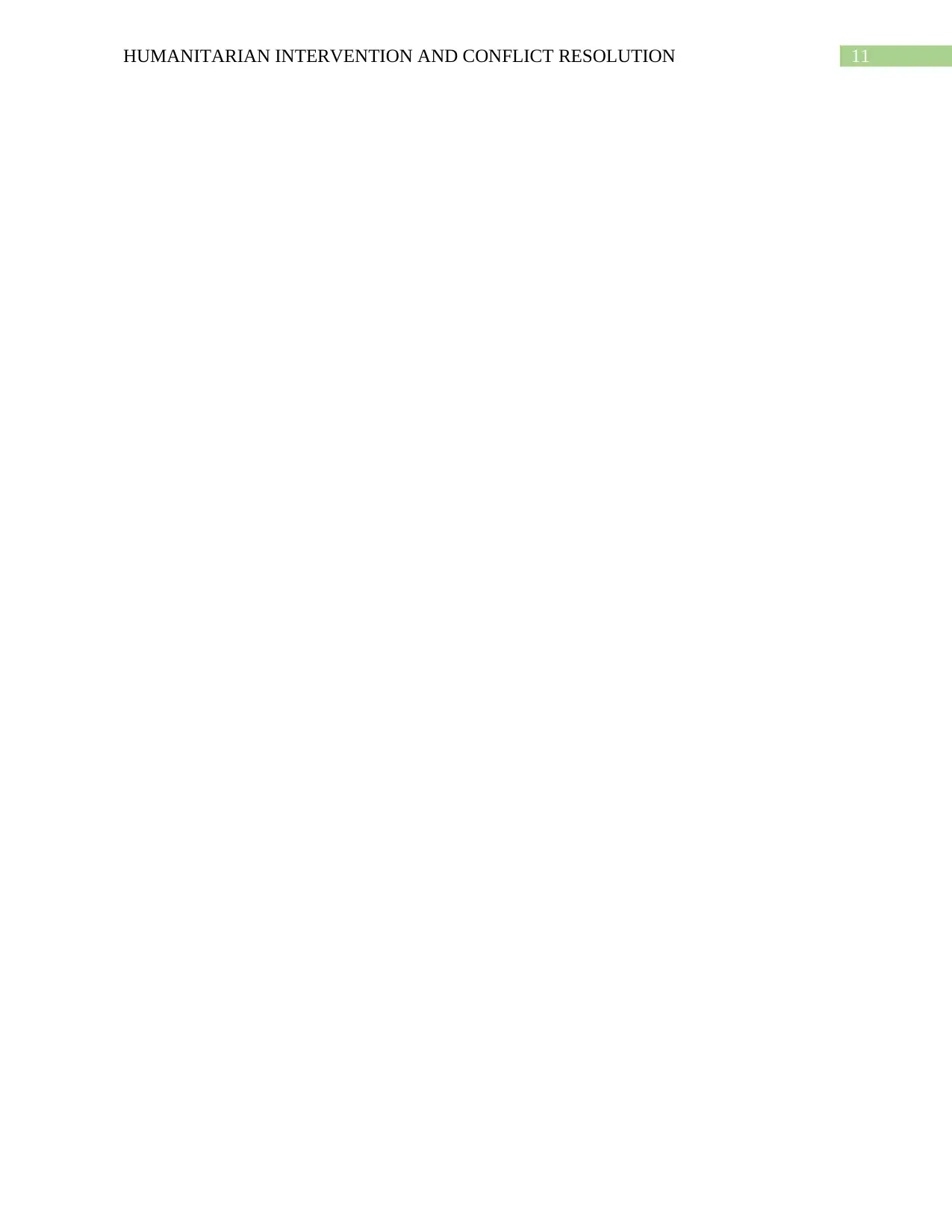
11HUMANITARIAN INTERVENTION AND CONFLICT RESOLUTION
1 out of 12
Related Documents
Your All-in-One AI-Powered Toolkit for Academic Success.
+13062052269
info@desklib.com
Available 24*7 on WhatsApp / Email
![[object Object]](/_next/static/media/star-bottom.7253800d.svg)
Unlock your academic potential
© 2024 | Zucol Services PVT LTD | All rights reserved.





